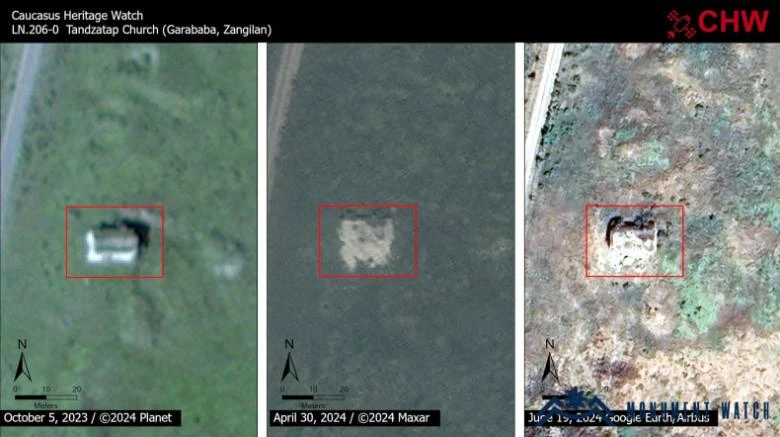The website monumentwatch.org, which monitors the cultural heritage of Artsakh, referred to the destruction of the 19th century church in the Tandzatap village of the Kashatagh region of Artsakh by Azerbaijan.
"According to the observation of satellite photos by the Caucasus Heritage Watch organization, between October 2023 and April 2024, the Azerbaijani side destroyed the 19th century church in the Tandzatap village of the Kashatagh region of occupied Artsakh.
The church was built in the second half of the 19th century. Around the church there was a simultaneous extensive cemetery, which was destroyed by the Azerbaijani side back in 1989-1993, and in those years the Azerbaijani side also deliberately damaged the church.
The tombstones containing Armenian inscriptions, the khachkars of the surrounding areas were particularly destroyed. The village of Tandzatap was once a part of the historical Kovsa province. , Armenian cemeteries, and the last Armenian villages were depopulated in the 1960s.
The process of depopulation of the Armenian villages of the region and settlement of the territory with Azerbaijanis began in the 1930s, when the Zangelan region was formed, which included a significant part of Kovsakan.
Before 1993, when the region was liberated, the Azerbaijani side had significantly destroyed most of the monuments showing the Armenianness of the region by demolishing, making the churches into a state of emergency, erasing, scraping the Armenian inscriptions, etc.
We can state that by destroying the Tandzatap church, the Azerbaijani side continues and seems to eliminate the last evidence of the Armenianness of the region.
Our response
The deliberate destruction of the Tantsatap church violates Article 8 of the Rome Statute and is considered a grave crime against humanity. Damage to the church according to the 1954 Hague Convention on the Protection of Cultural Property in Armed Conflict. Article 4 of the Convention and additionally, 1999 Article 15(a) of the adopted Second Protocol is a "serious violation" which, as a war crime, can be prosecuted in international courts.
The destruction of the Tandzatap church is also a genocidal act, because today the issue of genocide is also considered in the context of attacks on cultural heritage. The Manual for the Examination of the Cultural Heritage Provisions of the Rome Statute states:
"Crimes against or affecting cultural heritage are often linked to genocide or committed as part of it. The destruction of cultural heritage can cause serious psychological harm to people, increasing the gravity and seriousness of genocidal acts under Article 6 (b) of the Rome Statute.
In addition to physical damages, the destruction of the Tandzatap church leaves deep emotional and cultural consequences for the affected community, being considered a gross violation of the right to the culture of Artsakh Armenians and the entire Armenian people.
Article 27 of the Declaration "On Human Rights and Fundamental Freedoms" defines the universal guarantee of cultural rights:
"Everyone has the right to participate freely in the cultural life of the community, to enjoy the arts, to participate in scientific progress and its benefits."
In addition, Article 4 of the "Universal Declaration on Cultural Diversity" and Paragraph 4 of "Resolution 10/23 of the Human Rights Council" state that no one can violate the human rights guaranteed by international law, nor limit their scope.


